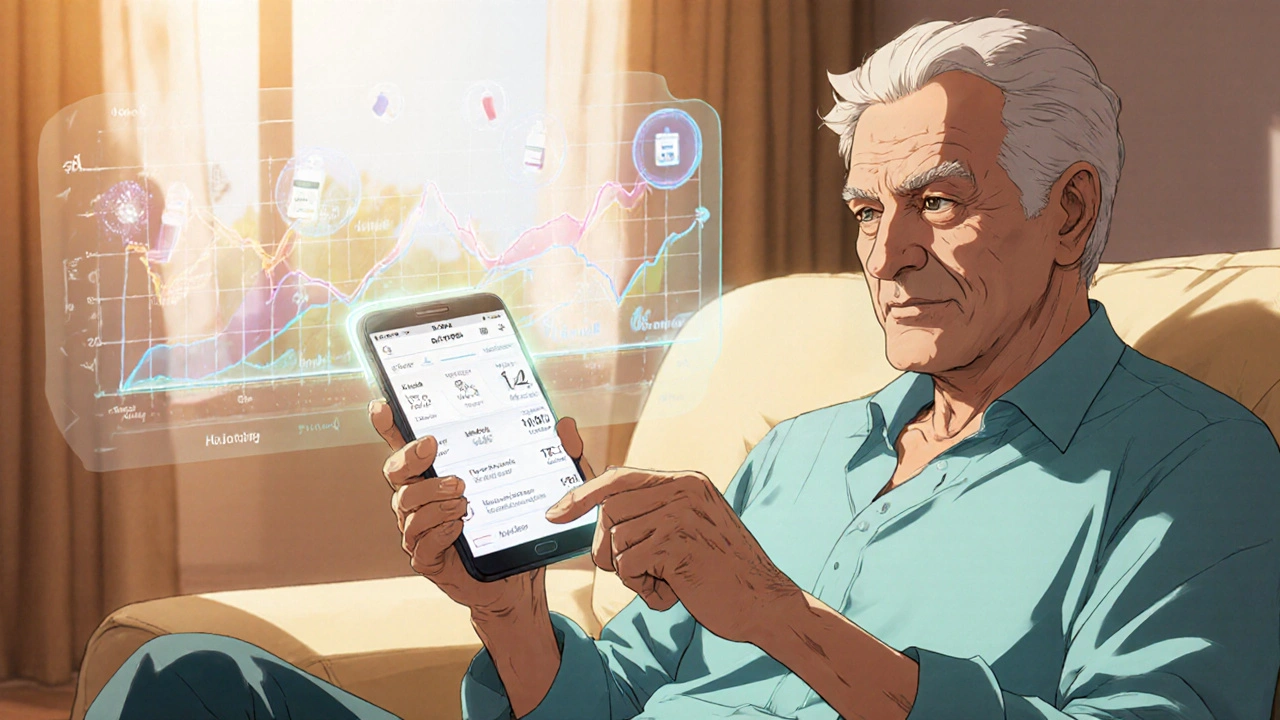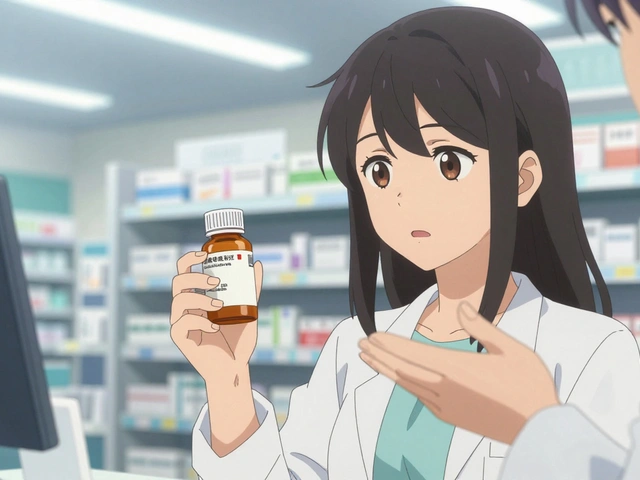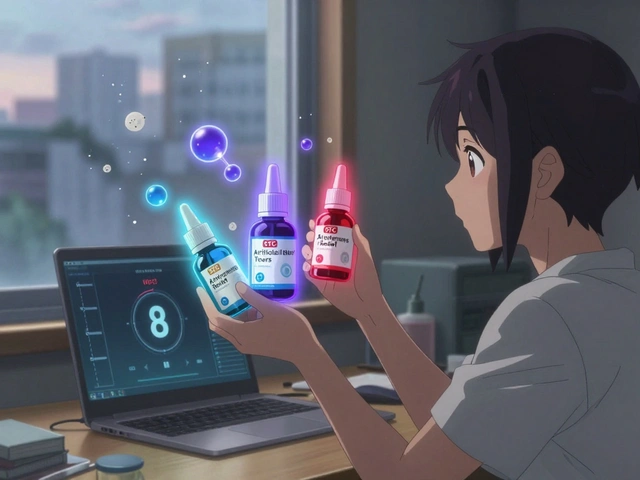Medication Adherence Improvement Calculator
How Digital Therapeutics Improve Your Health
Digital therapeutics (DTx) are FDA-cleared software programs that help you take your medications consistently. By improving adherence, they can lead to better health outcomes for chronic conditions like diabetes, depression, and asthma.
Key findings from clinical studies: DTx can:
- Reduce HbA1c by 1.2% for diabetes patients
- Decrease illicit opioid use by 16.3% for patients on buprenorphine
- Improve adherence by 22-28 percentage points for asthma/COPD
By 2025, digital therapeutics are no longer experimental. They’re prescribed alongside pills, patches, and injections - and they’re changing how medications work in real life. You might not realize it, but if you’re managing diabetes, depression, or high blood pressure, you could already be using one. These aren’t fitness apps or meditation tools. They’re FDA-cleared software programs designed to treat disease. And just like any drug, they can interact with the medications you’re already taking.
What Exactly Are Digital Therapeutics?
Digital therapeutics (DTx) are software-based treatments that deliver clinical interventions directly to patients. Think of them as apps that have been tested in clinical trials and approved by the FDA as medical devices. Unlike wellness apps that encourage walking or sleep tracking, DTx are meant to treat specific conditions - like anxiety, ADHD, or type 2 diabetes - using evidence-based methods such as cognitive behavioral therapy (CBT), biofeedback, or personalized coaching.
The first FDA-cleared prescription DTx was reSET in 2018 for substance use disorder. Since then, the list has grown. In September 2024, the FDA approved DaylightRx, a 90-day CBT program for generalized anxiety disorder in adults. Others include EndeavorRx for pediatric ADHD and DarioEngage for diabetes management. These aren’t add-ons. They’re part of the treatment plan - prescribed by a doctor, covered by insurance in some cases, and tracked like any other medication.
How DTx Improve Medication Adherence
One of the biggest problems in modern medicine? Patients don’t take their meds as directed. Studies show up to 30% of prescriptions are never filled. Even when filled, only about half of people with chronic conditions take their pills consistently. That leads to hospitalizations, complications, and higher costs.
Digital therapeutics fix this by doing what phone alarms and pill organizers can’t: they adapt. Apps like Medisafe track when you open your pill bottle, remind you before a dose, and ask how you’re feeling. If you skip a dose, the app doesn’t just nag - it offers support. Maybe you’re afraid of side effects. Maybe you can’t afford the next refill. The app connects you to financial aid, explains what to expect, or even nudges your doctor.
Real results? In diabetes, DTx paired with insulin therapy led to 1.2% greater HbA1c reduction over six months than medication alone. For mental health, one DTx used with buprenorphine cut illicit opioid use by 16.3% more than the drug by itself. In asthma and COPD, adherence jumped 22-28 percentage points above standard care.
When DTx and Medications Interact - It’s Not Just About Side Effects
Most people think of drug interactions as one pill canceling out another. With DTx, it’s different. The interaction isn’t chemical - it’s behavioral and physiological.
For example, someone on warfarin (a blood thinner) might use a DTx app that tracks daily activity, sleep, and diet. If the app notices you’ve been eating more leafy greens (which affect vitamin K levels), it might alert your provider to check your INR sooner. That’s not a drug interaction - it’s a data-driven adjustment to your medication plan.
Another example: a patient on antidepressants uses a DTx for anxiety. The app detects increased heart rate and restlessness during certain times of day. It flags this to the clinician, who realizes the patient’s SSRI dose might be too high. The app didn’t interfere with the drug - it gave the doctor better information to adjust it.
But there’s risk. Some DTx use gamification - like earning points for completing CBT modules. In clinical trials for EndeavorRx (used for ADHD), 7% of users reported headaches, dizziness, or emotional distress. For someone already on stimulants like Adderall, that could mean amplified side effects. No one’s proven a direct pharmacological interaction yet - but the behavioral overlap? That’s real.

Who Benefits Most - And Who Gets Left Behind
Digital therapeutics work best for chronic conditions that need daily behavior change. Diabetes. Mental health. COPD. Heart failure. These are conditions where consistency matters more than a single dose.
But they don’t work for everyone. Patients over 65 without tech support are 45% more likely to quit using DTx. In one study, 38% of people over 70 stopped within 30 days because they couldn’t figure out the app. That’s not a failure of the technology - it’s a failure of the rollout.
Successful programs pair DTx with human support. A “DTx navigator” helps patients set up the app, troubleshoot login issues, and connect app alerts to real-life decisions. Clinics that do this see discontinuation rates drop by 33%.
Also, not all apps are created equal. Only FDA-cleared DTx have proven clinical benefit. Thousands of wellness apps claim to help with anxiety or sleep - but if it’s not prescribed and cleared by the FDA, it’s not a DTx. It’s a tool. And tools don’t replace medicine.
Regulation, Reimbursement, and the Road Ahead
The FDA treats DTx like medical devices. Prescription DTx need 510(k) clearance or De Novo classification. That means real data - randomized trials, patient outcomes, safety monitoring. Non-prescription apps? No such rules.
That’s why experts are pushing for clearer standards. The FDA plans to release new guidance in mid-2025 focused specifically on how DTx interact with medications. Right now, there’s no requirement for DTx makers to study how their software affects drug metabolism, absorption, or side effects. That’s changing.
Reimbursement is another hurdle. Medicare and private insurers are slowly covering DTx, but only if they’re prescribed and tied to specific codes. By 2027, Medisafe predicts 65% of specialty pharmacy prescriptions will require a DTx companion just to qualify for coverage. That’s not far off.
Pharmaceutical companies are already on board. Seventy-eight percent of the top 20 drug makers now bundle DTx with their high-cost medications - especially for diabetes, multiple sclerosis, and rare diseases. Why? Because when patients stick to their meds, fewer get sick, fewer go to the ER, and the drug works better.

What Patients Should Ask Their Doctor
If your doctor suggests a DTx, don’t just download the app. Ask these questions:
- Is this FDA-cleared as a prescription digital therapeutic? (Not just a wellness app.)
- What condition is it meant to treat - and how does it work with my current meds?
- Will my data be shared with my pharmacy or EHR? How is it protected?
- Is there a support person I can call if I get stuck?
- Will my insurance cover it? What if I can’t use it?
And if you’re already using one, track your experience. Did your blood sugar improve? Did your anxiety feel more manageable? Did you miss fewer doses? Write it down. That’s the data your doctor needs to make better decisions.
The Future: DTx as Part of Your Treatment Algorithm
In five years, digital therapeutics won’t be a “new thing.” They’ll be standard - like stethoscopes or blood pressure cuffs. Imagine a patient with type 2 diabetes: their CGM feeds data into a DTx app. The app notices their glucose spikes after meals on weekends. It suggests a small carb adjustment and reminds them to take their metformin 20 minutes before eating. It sends a summary to their endocrinologist every Monday. If their HbA1c drops below 7%, the app reduces the frequency of reminders. If it rises, it flags the provider for a dose change.
This isn’t sci-fi. It’s already happening in pilot programs. The goal isn’t to replace doctors or drugs. It’s to make both work better - together.
The biggest risk isn’t technology. It’s inequality. If only tech-savvy, younger, wealthier patients get access to DTx, we’ll widen the health gap. That’s why training, support, and equitable access must be built in - not added later.
Digital therapeutics aren’t magic. But when used right, with the right meds, and the right support - they’re one of the most powerful tools we’ve had in decades to help people stay healthy.
Are digital therapeutics the same as wellness apps like Headspace or Fitbit?
No. Wellness apps promote general health - like improving sleep or reducing stress. Digital therapeutics (DTx) are FDA-cleared medical treatments designed to diagnose, manage, or treat specific diseases. For example, DaylightRx is a DTx for generalized anxiety disorder, while Headspace is a mindfulness app. Only DTx require a prescription, have clinical trial data backing their claims, and are regulated like medical devices.
Can digital therapeutics replace my medication?
Sometimes - but not usually. Most DTx are designed as adjuncts, not replacements. For example, EndeavorRx is approved for ADHD in children aged 8-12 as an alternative to stimulants, but only if parents and doctors agree it’s appropriate. For conditions like diabetes or hypertension, DTx improve adherence and outcomes but don’t eliminate the need for insulin or blood pressure pills. Always consult your doctor before stopping any medication.
Do digital therapeutics interact with my drugs the way two pills do?
Not chemically. DTx don’t contain active pharmaceutical ingredients, so they don’t alter how your body absorbs or breaks down drugs. But they can affect how you take them. For example, a DTx that reduces anxiety might make you less likely to skip your antidepressant. Or, if it causes headaches or frustration, it could worsen side effects from stimulants. The interaction is behavioral, not pharmacological - but it’s still clinically important.
Is my data safe when I use a digital therapeutic?
It depends. FDA-cleared DTx must follow HIPAA and other privacy standards, but not all apps do. Prescription DTx typically encrypt data and limit access to your care team. Non-prescription apps may sell data to advertisers. Always check the app’s privacy policy. Ask your provider: “Will my data go into my electronic health record? Who else sees it?” If you’re unsure, don’t use it.
What if I’m over 65 and not good with technology?
You’re not alone. Studies show patients over 65 are much more likely to stop using DTx without help. If your doctor recommends one, ask if your clinic offers a “DTx navigator” - a staff member who helps you set up the app, answers questions, and troubleshoots issues. Many clinics now provide this service. Don’t try to figure it out alone. You don’t need to be tech-savvy - you just need support.
Will my insurance cover a digital therapeutic?
Some do - but not all. Coverage is growing, especially for DTx linked to chronic conditions like diabetes, mental health, or COPD. Medicare and major insurers are starting to reimburse for FDA-cleared DTx when prescribed by a provider and tied to specific billing codes. But many still don’t cover them. Ask your doctor or pharmacist: “Is this covered under my plan? What’s the code?” If it’s not covered, ask if there’s a patient assistance program.











Jennifer Skolney
November 21, 2025 AT 20:58 PMDigital therapeutics are changing the game, but I’ve seen too many older patients get overwhelmed by them. My mom tried one for her diabetes and just gave up after three days because the app kept asking her to log meals she didn’t know how to measure. It’s not the tech’s fault-it’s the design. We need simpler interfaces and real human backup, not just a chatbot that says ‘Try again tomorrow.’
Olanrewaju Jeph
November 21, 2025 AT 21:48 PMIt's crucial to distinguish between digital therapeutics and wellness apps. Many patients confuse the two, leading to dangerous assumptions. A DTx like DaylightRx has undergone rigorous clinical trials and is regulated as a medical device. Wellness apps, no matter how well-designed, lack the evidence base to be considered treatment. This distinction must be emphasized in patient education materials.
Dalton Adams
November 22, 2025 AT 02:16 AMLet’s be honest-most of these DTx are just glorified behavioral nudges wrapped in FDA paperwork. The science is solid, sure, but the real innovation isn’t the software-it’s the fact that insurers are finally paying for it. Pharma companies are bundling these because they know adherence = profit. And let’s not pretend the 7% of users who get headaches from EndeavorRx are just ‘experiencing side effects’-that’s a direct behavioral interaction with stimulants. We’re ignoring the pharmacodynamic overlap because we don’t have the right metrics yet. The FDA’s new guidance better include real-time physiological feedback loops, or we’re just building digital placebo machines.
Kane Ren
November 22, 2025 AT 09:09 AMThis is actually really hopeful. I’ve been on meds for depression for years, and the one thing that finally helped me stick with them was a DTx app that didn’t just remind me-it asked how I was feeling and gave me a tiny CBT exercise when I said ‘bad.’ It didn’t cure me, but it made me feel seen. If we can scale this with support, not just tech, we’re talking about real change.
Charmaine Barcelon
November 24, 2025 AT 00:34 AMPeople are so excited about this tech, but they’re ignoring the biggest problem: if you’re not young, rich, and white, you’re probably not getting access. My cousin in rural Alabama got prescribed a DTx for hypertension-and she doesn’t even have reliable Wi-Fi. This isn’t progress. It’s exclusion with a fancy app.
Karla Morales
November 25, 2025 AT 18:18 PMLet’s analyze the data: 38% of users over 70 discontinue DTx within 30 days. That’s not a user issue-it’s a systemic failure. The interface design assumes digital literacy that simply doesn’t exist in that demographic. Furthermore, the lack of standardized interoperability with EHRs creates dangerous fragmentation. Until DTx vendors comply with FHIR standards and undergo mandatory usability testing with elderly populations, this remains a luxury for the privileged. 📊
Javier Rain
November 25, 2025 AT 21:35 PMI’ve seen this work in my clinic. We paired a DTx for COPD with a nurse navigator-someone who called patients every other day to help them log symptoms and reset reminders. Discontinuation dropped from 45% to 12%. It’s not the app. It’s the human connection. We need to fund these roles, not just the software. This isn’t tech-it’s care.
Laurie Sala
November 26, 2025 AT 09:05 AMUgh, I tried one of these apps for anxiety… it kept telling me to ‘breathe’ and ‘reflect’ when I was already on SSRIs and feeling like I was drowning. I didn’t need another voice telling me what to do-I needed my doctor to adjust my dose. These apps make you feel guilty for not being ‘engaged enough.’
Manjistha Roy
November 27, 2025 AT 06:41 AMI work with patients in rural India, and we’ve adapted DTx by using voice-based interfaces in local languages. No screens. No typing. Just a call from the app asking, ‘How are you feeling today?’ and logging responses. It’s not flashy, but it works. The tech isn’t the barrier-it’s the assumption that everyone speaks English, has a smartphone, or reads at a high school level. We need to design for the margins, not the middle.
Lisa Detanna
November 28, 2025 AT 08:10 AMAs someone who grew up in a household where mental health was never discussed, I’m grateful these tools exist-but they’re useless if we don’t pair them with cultural context. A CBT app that assumes you have a stable home, a supportive family, and the freedom to talk about your feelings? That’s not universal. We need DTx that adapt to trauma, poverty, and stigma-not just to heart rate and sleep cycles.
Demi-Louise Brown
November 28, 2025 AT 17:42 PMDTx are not replacements. They are enhancers. Their value lies in continuous, passive monitoring and behavioral reinforcement. When paired with traditional pharmacotherapy, outcomes improve significantly. The challenge is integration-not innovation. Seamless data flow to EHRs, clinician alerts based on thresholds, and patient-centered design are the next frontiers.
JD Mette
November 30, 2025 AT 06:48 AMI appreciate the optimism here, but let’s not pretend this is accessible to everyone. My brother, who’s 68 and has Parkinson’s, was given a DTx for depression. He couldn’t tap the buttons fast enough. No one offered him a voice-controlled version. No one followed up. He stopped after a week. It’s not that he didn’t want to help himself. It’s that the system didn’t help him help himself.